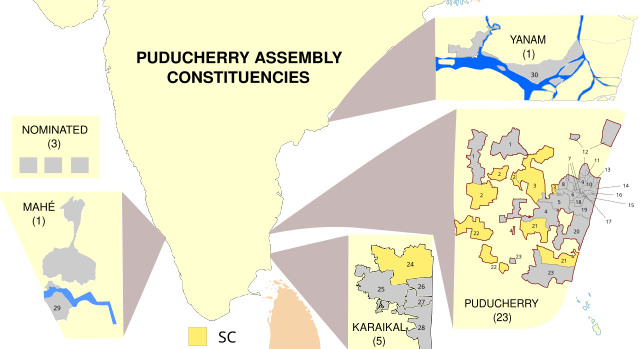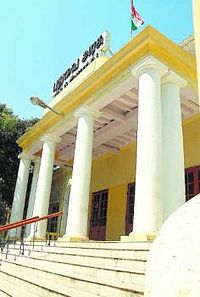Top Qs
Timeline
Chat
Perspective
Puducherry Legislative Assembly
Unicameral legislature of the Indian union territory of Puducherry From Wikipedia, the free encyclopedia
Remove ads
The Puducherry Legislative Assembly (French: Assemblée législative de Pondichéry) is the unicameral legislature of the Indian union territory (UT) of Puducherry, which comprises four districts: Puducherry, Karaikal, Mahé and Yanam. Out of eight union territories of India, only three have legislatures and they are Delhi[note 1], Puducherry[note 2] and Jammu and Kashmir[note 3]. After delimitation shortly after its formation, the Puducherry legislative assembly has 30 seats, of which 5 are reserved for candidates from scheduled castes and 3 members are nominated by the Government of India. 30 members are elected directly by the people based on universal adult franchise . These nominated members enjoy the same powers as elected members of the assembly.

Remove ads
Geographically, the area under the Puducherry UT consists of three disjointed regions, with Puducherry and Karaikal districts surrounded by districts of Tamil Nadu, Yanam district an enclave of East Godavari district of Andhra Pradesh, and Mahé district bordered by districts of Kerala. The four districts were ruled by the French before they were integrated into India in 1962. For ease of administration, during French rule, the area under these four districts was divided into 39 assembly constituencies. After becoming a UT of India, Puducherry was divided into 30 assembly constituencies, which were restructured in 2005 by the Delimitation Commission of India.
Remove ads
History
Summarize
Perspective
Assembly during French rule
In 1946, French India (Inde française) became Overseas territory (Territoire d'outre-mer) of France. Then a Representative Assembly (Assemblée représentative) was created. Thus, in 1946, on 25 October, the representative assembly of 44 members has replaced the general council (conseil général).[6] The Representative Assembly had 44 seats until merger of Chandernagore in 1951. Later, it reduced to 39 seats.
Merger and formation of Union Territory
The French government transferred the four enclaves to the Indian Union under a de facto treaty on 1 November 1954.[7] Later the territory was merged with India on 16 August 1962.
On 10 May 1963, the Indian Parliament enacted the Government of Union Territories Act, 1963 that came into force on 1 July 1963. This introduced the same pattern of government that prevailed in the rest of the country, but subject to certain limitations.[8] Under Article 239 of the Indian Constitution, the President of India appoints an Administrator LG with such designation as he may specify to head the administration of the territory. The President also appoints the Chief Minister. The President, on the advice of the Chief Minister, appoints the other Ministers. The Union Territories Act, 1963 limits the number of elected members of the assembly to 30 and allows the central government to appoint not more than 3 nominated MLAs. The same act ensures that seats are reserved for Scheduled Castes in the legislative assembly.
The Representative Assembly was converted into the Legislative Assembly of Pondicherry on 1 July 1963 as per Section 54(3) of The Union Territories Act, 1963[8] and its members were deemed to have been elected to the Assembly.[9]: 966 Thus, the First Legislative Assembly was formed without an election. Elections for the assembly have been held since 1964.
Remove ads
Etymology
Puducherry has five official names, owing to its linguistic diversity, past French heritage, and the legacy of British India.[10] The legislative assembly is referred to as follows:
Remove ads
List of the assemblies
Summarize
Perspective
Remove ads
Members of the Legislative Assembly
Remove ads
Party position
See also
- Yanam Municipal Council
- Puducherry Municipal Council
- List of chief ministers of Puducherry
- Puducherry (Lok Sabha constituency)
- List of lieutenant governors of Puducherry
- List of Rajya Sabha members from Puducherry
- List of speakers of the Puducherry Legislative Assembly
- List of constituencies of Puducherry Legislative Assembly
- List of leaders of the opposition in the Puducherry Legislative Assembly
Remove ads
Notes
- 30 directly elected members and 3 appointed members by the Government of India.
- 6 directly elected and 3 appointed by the Government of India.
References
External links
Wikiwand - on
Seamless Wikipedia browsing. On steroids.
Remove ads



